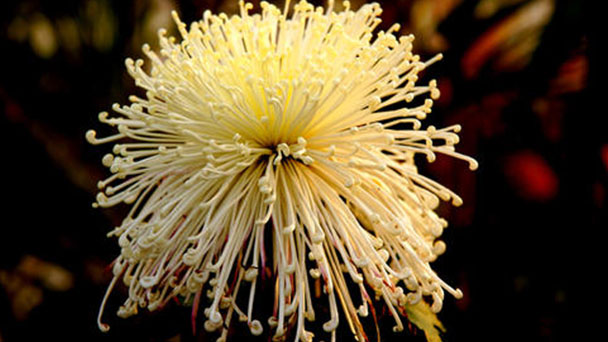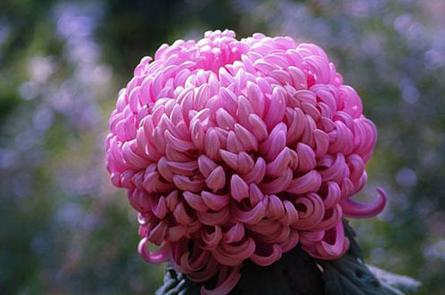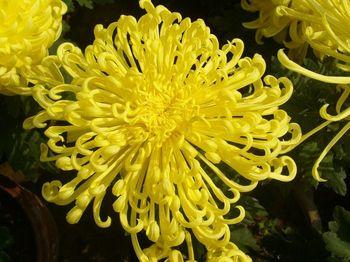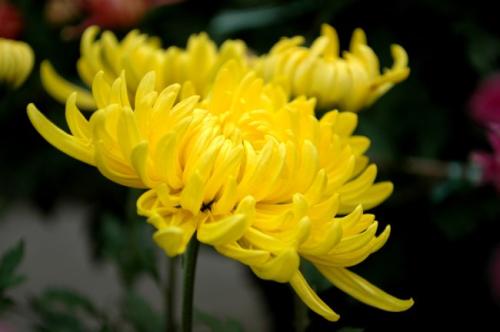Chrysanthemum Profile: Grow & Care For Mums
Written by Maggie
Oct 28 2021

Chrysanthemum, also called mums is the most important flower crop in East Asia and one of the three most important flowers in Europe and America. The flower shape is various, easy to adjust maternity leave, and can provide anniversary of cut flowers.
Chrysanthemum Picture
Chrysanthemum Characteristics
The Chrysanthemum (mums) is a perennial herb with a height of 60-150 cm. Stems are erect, branched or unbranched, pilose. Leaves are alternate, short stipitate, leaf blade ovate to lanceolate, 5 -- 15 cm long, pinnately lobed or semi-lobed, base cuneate, underside white pubescent, margin coarsely serrate or deeply lobed, base cuneate, stipitate. Inflorescences of Chrysanthemum are solitary or in clusters, 2.5-20 cm in diameter, varying in size, single or in clusters at the apex of a stem or branch; Due to the variety, the difference is very big. Involucral bracts are multilayered, outer green, striate, margin membranous, outside pilose; Ligulate flowers of Chrysanthemum are red, yellow, white, orange, purple, pink, dark red and so on. There are many varieties of breeding. The head inflorescences are varied and the shapes and colors are different.
Young stems of Chrysanthemum are pale green or brownish, gray pilose, or tomentose. The stem is mostly dead after the flower. The following spring by the underground stem produced evil buds. The leaves of Chrysanthemum (mum) are simple and alternate, petiole 1 -- 2 cm long, spikeless or degenerated on both sides below the petiole, ovate to oblong, margins are notched and serrated.
The morphology of the Chrysanthemum leaves varies by species and can be divided into 8 types: regular leaves, deep regular leaves, long leaves, deep long leaves, round leaves, sunflower leaves, coniferous leaves and boat leaves. Flowers (head) of Chrysanthemum, occurring at branch tops, about 2 -- 30 cm in diameter, with green buds forming outside the inflorescence.
Inflorescence of Chrysanthemum has two forms of flowers: a simple flower, commonly known as the "center", corolla linked into a simple, bisexual flower, the center of a pistil, stigma 2 lobes, ovary lower position 1 cell, around the main 5 ZiZi gather medicine stamen; Another is the lingual flower and is born in the inflorescence edge, commonly known as "petal", the stamen inside the flower degenerates, pistil.
Chrysanthemum Habit
The optimum temperature for Chrysanthemum (mums) growth was 18 ~ 21℃, the maximum temperature was 32℃, the lowest temperature was 10℃, and the low-temperature tolerance limit of underground rhizome was generally -10℃. The lowest night temperature at the flowering stage is 17℃, and it can be reduced to 15 ~ 13℃ at the flowering stage (middle and late). Chrysanthemum likes the full sun, but also slightly tolerant of shade. Chrysanthemum is resistant to dryness and avoids waterlogging. Chrysanthemum likes high and dry terrain, deep soil layer, rich in humus, easy and fertile and good drainage sandy loam.

How to Care for Chrysanthemum
1. Sunlight
Chrysanthemum (mums) plants are positive and have different requirements for light in different growth and development stages. Adequate sunlight is required for vegetative growth and development. After the buds have unfurled and the plant stops growing, full sunlight is no longer needed and shade or semi-shade is available. Accordingly, Chrysanthemum can be placed indoors for a long time, extending the flowering period and ornamental time. If cross-breeding is required, sufficient sunlight should be given during and after flowering in order to produce full and full seeds.
2. Environment
The Chrysanthemum likes a wet and cool ecological environment and has some cold resistance and frost resistance. In the hot summer the growth is mostly in a semi-stop state; After the beginning of autumn, the Chrysanthemum growth is vigorous, when the stem is thickened, the leaves are enlarged, and the flower buds begin to differentiate.
3. Soil Care
Loose, fertile, humus-rich, aerated and permeable sandy loam is favored by Chrysanthemum. The soil pH value is 6.0-8.0 in the slightly acidic, neutral and alkaline soil that can grow, not too strong acid and alkali.
4. Watering & Fertilizer
The growth of Chrysanthemum (mums) with strong drought resistance was best under the condition of 60% soil moisture. In different growth and development periods, the requirements of water and fertilizer are different. There is a saying among flower growers in the old producing areas of Wangjing-Zhuang Village, Yanling County: "The young are afraid of drowning, the old are afraid of early, and they are large-bellied when the bud is formed". That is to say, the Chrysanthemum is afraid of water inundation at the seedling stage (vegetative growth), and should be applied frequently with small water and small fertilizer. In the Chrysanthemum bud formation and pregnant bud process, to large water-fat (is 2-3 times the seedling stage) timely use. This is conducive to big flowers, more flowers, flowers.
5. Timely heart can promote lateral branches, effectively depressing plant height. Picking the heart time and times of potted plants vary due to different shape selection arts. Generally, 4-7 flowers are left. After the planting of chrysanthemum seedlings, 4-5 leaves are left to pick the heart, and when the lateral branches grow 4-5 leaves, 2-3 leaves are left for the second time.
Chrysanthemum Flower Language
The Chrysanthemum has always been regarded as the symbol of solitary mark bright festival, elegant and proud frost, its main words are pure, noble, longevity, good luck, true love.

Read Next:
How to Propagate Mums (Chrysanthemum)
Top 10 Most Beautiful Roses in the World
Top 10 Most Beautiful Flowers in the World
26 Best Autumn Flowers to Plant for Fall Color in Garden
Latest Updated
- Benefits of Bugleweed - 7 Science-backed Health Benefits
- Bugleweed Dangers & Side Effects - Is It Poisonous?
- How to Plant Evergreen Trees - What You Should Know
- When to Plant Evergreens - Grow Guide for Evergreen Trees
- 12 Wonderful Evergreen Shrubs for Your Garden
- 12 Popular Evergreen Plants with Pictures for Beginners
- When And How To Prune A Lilac Bush Like a Pro
- How to Grow & Care for Lilac Vine (Hardenbergia Violacea)
- Japanese Lilac Tree (Syringa Reticulata) Care & Propagation Guide
- Shumard Oak Pros and Cons - What to Know
Popular Articles
- Winter maintenance of Antirrhinum Majus
- How to Grow Terminalia Mantaly Tree
- How to Grow and Care for Crossostephium Chinense
- How to grow Antirrhinum Majus in spring
- Peristeria Elata (Dove Orchid) Profile: Info & Care Guide
- Underwatered Snake Plant (Sansevieria Trifasciata) - Signs And How To Fix
- How to Care for Brazilian Jasmine Plant (Mandevilla Sanderi)
- How to Grow & Care for Graptopetalum Purple Delight in Summer
- Rosa Chinensis (China Rose): Plant Growing & Care Tips
- How to Care for Baby Sun Rose (Aptenia Cordifolia)
